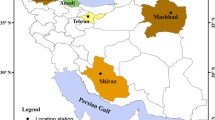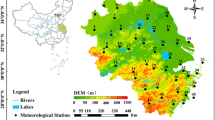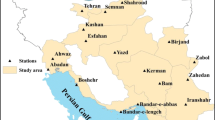Abstract
We have analyzed the trends of reference crop evapotranspiration (ET0) through the Penman–Monteith model and climate factors in the West Liao River basin using the Mann–Kendall test after removing the effect of significant lag-1 serial correlation from the time series of the data by trend-free pre-whitening. The changing characteristics of the sensitivity coefficients and the spatial distribution during growing season are investigated, and the correlation between the sensitivity coefficients with elevation and the key climate factors by relative contribution and stepwise regression methods are evaluated. A significant overall increase in air temperature, and a significant decrease in wind speed, solar radiation, sunshine duration, relative humidity, and a slight decrease in ET0 are observed. Sensitivity analysis shows that ET0 is most sensitive to solar radiation, followed by relative humidity. In contrast, ET0 is least sensitive to the average air temperature. The sensitivity coefficients for the maximum and minimum air temperature and relative humidity have a significant negative correlation with elevation, while the coefficients for other variables are not strongly correlated with elevation. The spatial distribution of the sensitivity coefficients for wind speed and solar radiation is opposite, i.e., in regions where the sensitivity coefficients for wind speed are high; the sensitivity coefficients for solar radiation are low and vice versa. The sensitivity for relative humidity and average air temperature is region specific in the plain area. However, ET0 is most sensitive to the climate change in regions of high elevation. Wind speed is the most dominant contributor followed by solar radiation. Average air temperature contributes the least. The stepwise regression analysis indicates that wind speed is the foremost dominant variable influencing ET0. Relative contribution and stepwise regression analysis can be used to determine the main variables affecting ET0, and it also strongly supports that the aerodynamic component is the dominant factor.



Similar content being viewed by others
References
Allen RG, Pereira LS, Raes D, Smith M (1998) Crop evapotranspiration: guidelines for computing crop water requirements. FAO Irrigation and Drainage Paper 56. FAO, Rome, Italy
Angström A (1924) Solar and terrestrial radiation. Q J R Meteorol Soc 50:121–125
Bakhtiari B, Liaghat AM (2011) Seasonal sensitivity analysis for climatic variables of ASCE-Penman-Monteith model in the semi-arid climate. J Agric Sci Technol 13:1135–1145
Baumgartner A, Reichel E (1975) The world water balance: mean annual global, continental and maritime precipitation, evaporation and run-off. Elsevier Scientific Pub. Co, Amsterdam
Beven K (1979) A sensitivity analysis of the Penman-Monteith actual evapotranspiration estimates. J Hydrol 44:169–190
Birsan MV, Molnar P, Burlamdo P, Pfaundler M (2005) Streamflow trends in Switzerland. J Hydrol 314:312–329
Burman R, Pcchop LO (1994) Evaporation, evapotranspiration and climatic data. Elsevier, Amsterdam, p 278
Burn DH, Hesch NM (2007) Trends in evaporation for the Canadian prairies. J Hydrol 336(1–2):61–73
Burrough PA, McDonnel RA (1998) Principles of geographical information systems. Oxford University Press
Cannarozzo M, Noto LV, Viola F (2006) Spatial distribution of rainfall trends in Sicily (1921–2000). Phys Chem Earth 31:1201–1211
Cao W, Shen SH, Duan CF (2011) Quantification of the causes for reference crop Eapotranspiration changes in growing season in Northwest China. Acta Geograph Sin 66(3):407–415
Chattopadhyay N, Hulme M (1997) Evaporation and potential evapotranspiration in India under conditions of recent and future climate change. Agric For Meteorol 87:55–73
Chen S, Iu Y, Thomas A (2006) Climatic change on the Tibetan Plateau: potential evapotranspiration trend from 1961–2006. Clim Chang 76:291–319
Cohen S, Ianetz A, Stanhill G (2002) Evaporative climate changes at Bet Dagan, Israel, 1964–1998. Agric For Meteorol 111:83–91
Coleman G, DeCoursey DG (1976) Sensitivity and model variance analysis applied to some evaporation and evapotranspiration models. Water Resour Res 12(5):873–879
Darshana PA, Pandey RP (2013) Analysing trends in reference evapotranspiration and weather variables in the Tons River Basin in Central India. Stoch Env Res Risk A 27:1407–1421
Dinpashoh Y, Jhajharia D, Fakheri-Fard A, Singh VP, Kahya E (2011) Trends in reference crop evapotranspiration over Iran. J Hydrol 399:422–433
Dinpashoh Y, Mirabbasi R, ASCE SM, Jhajharia D, Abianeh HZ, Mostafaeipour A (2014) Effect of short-term and long-term persistence on identification of temporal trends. J Hydrol Eng 19(3):617–625
Douglas EM, Vogel RM, Kroll CN (2000) Trends in floods and low flows in the United States: impact of spatial correlation. J Hydrol 240(1–2):90–105
Elsawwaf M, Willenms P, Feyen J (2010) Assessment of the sensitisity and prediction uncertainty of evaporation models applied to Nasser Lake, Egypt. J Hydrol 395:10–22
Enku T, Melesse AM (2014) A simple temperature method for the estimation of evapotranspiration. Hydrol Process 28:2945–2960
Eslamian S, Khordadi MJ, Abedi-Koupai J (2011) Effects of variations in climatic parameters on evapotranspiration in the arid and semi-arid regions. Glob Planet Chang 78:188–194
Estévez J, Gavilán P, Berengena J (2009) Sensitivity analysis of a Penman-Monteith type equation to estimate reference evapotranspiration in southern Spain. Hydrol Process 23:3342–3353
Fu CC, Liu JP, Liu ZM (2009) Spacial and temporal differentiation rule of the climate change in Northeast Ch ina in about 60 years. J Arid Land Resour Environ 23(12):60–65
Gao G, Chen D, Ren GY, Chen Y, Liao YM (2006) Spatial and temporal variations and controlling factors of potential evapotranspiration in China: 1956–2000. J Geogr Sci 16(1):3–12
Gong LB, Xu CY, Chen DL, Halldin S, Chen YD (2006) Sensitivity of the Penman-Monteith reference evapotranspiration to key climatic variables in the Changjiang (Yangtze River) basin. J Hydrol 329:620–629
Goyal RK (2004) Sensitivity of evapotranspiration to global warming a case study of arid zone of Rajasthan (India). Agric Water Manag 69:1–11
Hamed KH (2008) Trend detection in hydrologic data: the Mann-Kendall trend test under the scaling hypothesis. J Hydrol 349:350–363
Huo ZL, Dai XQ, Feng SY, Kang SZ, Huang GH (2013) Effect of climate change on reference evapotranspiration and aridity index in arid region of China. J Hydrol 492:24–34
Hupet F, Vanclooster M (2001) Effect of the sampling frequency of meteorological variables on the estimation of the reference evapotranspiration. J Hydrol 243:192–204
Irmak S, Payero JO, Martin DL, Irmak A, Howell TA (2006) Sensitivity analyses and sensitivity coefficients of standardized daily ASCE-Penman-Monteith equation. J Irrig Drain Eng 132(6):564–578
Jhajharia D, Shrivastava SK, Sarkar D, Sarka S (2009) Temporal characteristics of pan evaporation trends under thehumid conditions of northeast India. Agric For Meteorol 149:763–770
Jhajharia D, Dinpashoh Y, Kahya E, Singh PV, Fakheri-Fard A (2012) Trends in reference evapotranspiration in the humid region of northeast India. Hydrol Process 26:421–435
Jhajharia D, Chattopadhyay S, Choudhary RR, Dev V, Singh VP, Lal S (2013) Influence of climate on incidences of malaria in the Thar Desert, northwest India. Int J Climatol 33:312–325
Jhajharia D, Kumar R, Dabral PP, Singh VP, Choudhary RR, Dinpashoh Y (2014a) Reference evapotranspiration under changing climate over the Thar Desert in India. Meteorol Appl. doi:10.1002/met.1471
Jhajharia D, Dinpashoh Y, Kahya E, Choudhary RR, Singh PV (2014b) Trends in temperature over Godavari River basin in Southern Peninsular India. Int J Climatol 34:1369–1384
Jia JY, Guo JP (2011) Characteristics of climate change in northeast China for last 46 years. J Arid Land Resour Environ 25(10):109–115
Jiang Y, Luo Y, Zhao Z, Tao S (2010) Changes in wind speed over China during 1956–2004. Theor Appl Climatol 99(3–4):421–430
Kendall MG (1975) Rank correlation methods. Charles Griffin, London, p 220
Kumar S, Merwade V, Kam J, Thurner K (2009) Streamflow trends in Indiana: effects of long term persistence, precipitation and subsurface drains. J Hydrol 374(1–2):171–183
Liang LQ, Li LJ, Liu Q (2010) Temporal variation of reference evapotranspiration during 1961–2005 in the Taoer River basin of Northeast China. Agric For Meteorol 150:298–306
Liu CM (2004) Study of some problems in water cycle changes of the Yellow River Basin. Adv Water Sci 15:608–614
Liu CM, Zhang D, Liu XM, Zhao CS (2012) Spatial and temporal change in the potential evapotranspiration sensitivity to meteorological factors in China (1960–2007). J Geogr Sci 22(1):3–14
Liu Q, Yang Z, Cui B, Sun T (2010) The temporal trends of reference evapotranspiration and its sensitivity to key meteorological variables in the Yellow River Basin, China. Hydrol Process 24:2171–2181
Mann HB (1945) Non-parametric tests against trend. Econometrica 13:245–259
McCuen RH (1974) A sensitivity and error analysis of procedures used for estimating evaporation. Water Resour Bull 10(3):486–498
McKenney MS, Rosenberg NJ (1993) Sensitivity of some potential evapotranspiration estimation methods to climate change. Agric For Meteorol 64:81–110
Meij AD, Pozzer A, Lelieveld J (2012) Trend analysis in aerosol optical depths and pollutant emission estimates between 2000 and 2009. Atmos Environ 51:75–85
Miralles DG, De Jeu RAM, Gash JH, Holmes TRH, Dolman AJ (2011) Magnitude and variability of land evaporation and its components at the global scale. Hydrol Earth Syst Sci 15(3):967–981
Modarres R, Sarhadi A (2009) Rainfall trends analysis of Iran in the last half of the twentieth century. J Geophys Res 114:1–9
McVicar TR, Roderick ML (2010) Atmospheric science: winds of change. Nat Geosci 3(11):747–748
McVicar TR, Roderick ML, Donohue RJ, Li LT, Van Niel TG, Thomas A et al (2012) Global review and synthesis of trends in observed terrestrial near-surface wind speeds: implications for evaporation. J Hydrol 416–417:182–205
Oki T, Kanae S (2006) Global hydrological cycles and world water resources. Science 313(5790):1068–1072
Piper BS (1989) Sensitivity of Penman estimates of evaporation to errors in input data. Agric Water Manag 15:279–300
Rana G, Katerji N (1998) A measurement based sensitivity analysis of the Penman-Monteith actual evapotranspiration model for crops of different height and in contrasting water status. Theor Appl Climatol 60:141–149
Roderick ML, Rotstayn LD, Farquhar GD, Hobbins MT (2007) On the attribution of changing pan evaporation. Geophys Res Lett 34:L17403
Ruelland D, Ardoin-Bardin S, Billen G, Servat E (2008) Sensitivity of a lumped and semi-distributed hydrological model to several methods of rainfall interpolation on a large basin in West Africa. J Hydrol 361:96–117
Saeid E, Mohammad JK, Jahangir AK (2011) Effects of variations in climatic parameters on evapotranspiration in the arid and semi-arid regions. Global Planet Chang 78:188–194
Saxton KE (1975) Sensitivity analysis of the combination evapotranspiration equation. Agric Meteorol 15:343–353
Sen PK (1968) Estimates of the regression coefficient based on Kendall’s Tau. J Am Stat Assoc 63:1379–1389
Sharifi A, Dinpashoh Y (2014) Sensitivity analysis of the Penman-Monteith reference crop evapotranspiration to climatic variables in Iran. Water Resour Manag 28:5465–5476
Shen YJ, Liu CM, Liu M, Zeng Y, Tian CY (2010) Change in pan evaporation over the past 50 years in the arid region of China. Hydrol Process 24:225–231
Singh VP, Xu CY (1997) Sensitivity of mass transfer based evaporation equations to errors in daily and monthly input data. Hydrol Process 11:1465–1473
Tabari H, Hosseinzadeh Talaee P (2014) Sensitivity of evapotranspiration to climatic change in different climates. Global Planet Chang 115:16–23
Tabari H, Somee BS, Zadeh MR (2011) Testing for long-term trends in climatic variables in Iran. Atmos Res 100(1):132–140
Theil H (1950) A rank invariant method of linear and polynomial regression analysis, Part 3. Proc K Ned Akad Wet 53:1397–1412
Thiessen AH (1911) Precipitation averages for large areas. Mon Weather Rev 39:1082–1084
Thomas A (2000) Spatial and temporal characteristics of potential evapotranspiration trends over China. Int J Climatol 20:381–396
Vautard R, Cattiaux J, Yiou P, Thépaut JN, Ciais P (2010) Northern hemisphere atmospheric stilling partly attributed to increased surface roughness. Nat Geosci 3(11):756–761
Vousoughi FD, Dinpashoh Y, Aalami MT, Jhajharia D (2013) Trend analysis of groundwater using non-parametric methods (case study: Ardabil plain). Stoch Env Res Risk A 27(2):547–559
Wang Y, Jiang T, Bothe O, Fraedrich K (2007) Changes of pan evaporation and reference evapotranspiration in the Yangtze River basin. Theor Appl Climatol 90:13–23
Wang EL, Wang SQ, Liu N (2012) Nitrate-nitrogen output flux simulation from different sandy soils in Western Liaohe River Basin. Res Environ Sci 25(2):165–172
Wang YJ, Li J, Lin ZH, Tong XJ, Xing LM (2013) Assessing the impacts of climate change on the potential evapotranspiration in the upper-middle reach of the Yellow River. Sci Soil Water Conserv 11(5):48–56
Xie JF, Zhang T, Zhang MY, Zhang H (2012) Change and reason analysis of ground solar Radiation in Northeast China over recent 50 years. Acta Energiae Solaris Sinica 33(12):2127–2134
Xu CY, Gong LB, Jiang T, Chen D, Singh VP (2006) Analysis of spatial distribution and temporal trend of reference evapotranspiration and pan evaporation in Changjiang (Yangtze River) catchment. J Hydrol 327:81–93
Yang GY, Wang ZS, Wang H, Jia YW (2009) Potential evapotranspiration evolution rule and its sensitivity analysis in Haihe River basin. Adv Water Sci 20(3):409–415
Yin YH, Wu SH, Chen G, Dai E (2010) Attribution analyses of potential evapotranspiration changes in China since the 1960s. Theor Appl Climatol 101:19–28
Yue S, Pilon P, Cavadias G (2002) Power of the Mann-Kendall and Spearman’s rho tests for detecting monotonic trends in hydrological series. J Hydrol 259(1–4):254–271
Zhang XT, Kang SZ, Zhang L, Liu JQ (2010) Spatial variation of climatology monthly crop reference evapotranspiration and sensitivity coefficients in Shiyang river basin of northwest China. Agric Water Manag 97:1506–1516
Zhang Q, Xu CY, Chen XH (2011) Reference evapotranspiration changes in China: natural processes or human influences? Theor Appl Climatol 103:479–488
Zeng LH, Song KS, Zhang B, Wang ZM (2010) Sensitive analysis on reference evapotranspiration to key meteorological factors in Northeast China. Chin J Agrom 31(1):11–18
Zhou Y, Zhang X, Xu J (2013) Changes of reference crop evapotranspiration and sensitivity analysis of meteorological factors in Eastern Plateau Agricultural Region of Qinghai Province. J Nat Resour 28(5):765–775
Zuo DP, Xu ZX, Yang H, Liu XC (2012) Spatiotemporal variations and abrupt changes of potential evapotranspiration and its sensitivity to key meteorological variables in the Wei River basin, China. Hydrol Process 26:1149–1160
Acknowledgments
We acknowledge the Water Conservation Department for the research grant and financial support. The granted research is titled as “Water-Ecology-Economy Security Study for the West Liao River Plain (201101021).” We also acknowledge the Chinese Meteorology Database (http://cdc.cma.gov.cn/) for the meteorology data used in this study. Suggestions and discussions from the reviewers of this paper are also greatly appreciated.
Author information
Authors and Affiliations
Corresponding author
Rights and permissions
About this article
Cite this article
Gao, Z., He, J., Dong, K. et al. Sensitivity study of reference crop evapotranspiration during growing season in the West Liao River basin, China. Theor Appl Climatol 124, 865–881 (2016). https://doi.org/10.1007/s00704-015-1453-7
Received:
Accepted:
Published:
Issue Date:
DOI: https://doi.org/10.1007/s00704-015-1453-7




